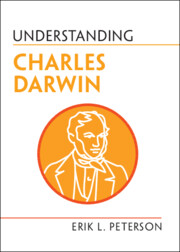Refine search
Actions for selected content:
12661 results in History of science
References
-
- Book:
- Understanding Charles Darwin
- Published online:
- 31 August 2023
- Print publication:
- 14 September 2023, pp 182-197
-
- Chapter
- Export citation
Contents
-
- Book:
- Understanding Charles Darwin
- Published online:
- 31 August 2023
- Print publication:
- 14 September 2023, pp xi-xii
-
- Chapter
- Export citation
Copyright page
-
- Book:
- Understanding Charles Darwin
- Published online:
- 31 August 2023
- Print publication:
- 14 September 2023, pp vi-vi
-
- Chapter
- Export citation
7 - The Struggle Is Real
-
- Book:
- Understanding Charles Darwin
- Published online:
- 31 August 2023
- Print publication:
- 14 September 2023, pp 147-169
-
- Chapter
- Export citation
Dedication
-
- Book:
- Understanding Charles Darwin
- Published online:
- 31 August 2023
- Print publication:
- 14 September 2023, pp ix-x
-
- Chapter
- Export citation
Summary of Common Misunderstandings
-
- Book:
- Understanding Charles Darwin
- Published online:
- 31 August 2023
- Print publication:
- 14 September 2023, pp 179-181
-
- Chapter
- Export citation
Concluding Remarks
-
- Book:
- Understanding Charles Darwin
- Published online:
- 31 August 2023
- Print publication:
- 14 September 2023, pp 170-178
-
- Chapter
- Export citation
Foreword
-
- Book:
- Understanding Charles Darwin
- Published online:
- 31 August 2023
- Print publication:
- 14 September 2023, pp xiii-xiv
-
- Chapter
- Export citation
4 - Darwin–Wallaceism
-
- Book:
- Understanding Charles Darwin
- Published online:
- 31 August 2023
- Print publication:
- 14 September 2023, pp 67-96
-
- Chapter
- Export citation
Figure Credits
-
- Book:
- Understanding Charles Darwin
- Published online:
- 31 August 2023
- Print publication:
- 14 September 2023, pp 198-199
-
- Chapter
- Export citation
2 - The Truth About Atolls
-
- Book:
- Understanding Charles Darwin
- Published online:
- 31 August 2023
- Print publication:
- 14 September 2023, pp 31-50
-
- Chapter
- Export citation
1 - The Evolutionary Darwins, 1794–1835
-
- Book:
- Understanding Charles Darwin
- Published online:
- 31 August 2023
- Print publication:
- 14 September 2023, pp 5-30
-
- Chapter
- Export citation
6 - Saint Charles’s Place
-
- Book:
- Understanding Charles Darwin
- Published online:
- 31 August 2023
- Print publication:
- 14 September 2023, pp 126-146
-
- Chapter
- Export citation
Introduction: The Legends of Charles Darwin
-
- Book:
- Understanding Charles Darwin
- Published online:
- 31 August 2023
- Print publication:
- 14 September 2023, pp 1-4
-
- Chapter
-
- You have access
- HTML
- Export citation
Index
-
- Book:
- Understanding Charles Darwin
- Published online:
- 31 August 2023
- Print publication:
- 14 September 2023, pp 200-208
-
- Chapter
- Export citation
Reviews
-
- Book:
- Understanding Charles Darwin
- Published online:
- 31 August 2023
- Print publication:
- 14 September 2023, pp vii-viii
-
- Chapter
- Export citation
Acknowledgments
-
- Book:
- Understanding Charles Darwin
- Published online:
- 31 August 2023
- Print publication:
- 14 September 2023, pp xv-xvi
-
- Chapter
- Export citation

Understanding Charles Darwin
-
- Published online:
- 31 August 2023
- Print publication:
- 14 September 2023
10 - Falling from Normalcy? Decolonisation of Museums, Science Centres, and Science Communication
-
-
- Book:
- Race and Socio-Cultural Inclusion in Science Communication
- Published by:
- Bristol University Press
- Published online:
- 24 January 2024
- Print publication:
- 31 July 2023, pp 160-175
-
- Chapter
- Export citation
PART III - The Decolonisation Agenda in Science Communication: Deconstructing Eurocentric Hegemony, Ideology, and Pseudo-historical Memory
-
- Book:
- Race and Socio-Cultural Inclusion in Science Communication
- Published by:
- Bristol University Press
- Published online:
- 24 January 2024
- Print publication:
- 31 July 2023, pp 147-148
-
- Chapter
- Export citation
